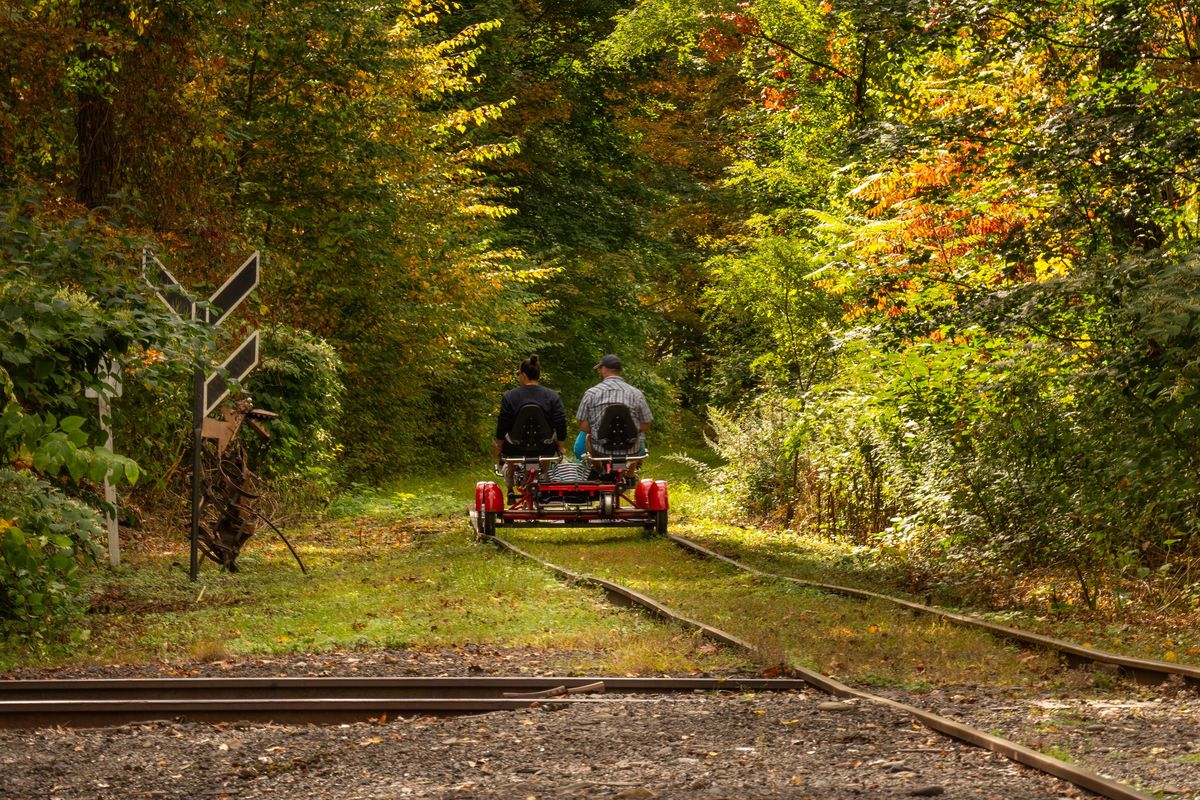Riding the rails, literally, on a pedal-powered bike

It’s always a thrill to pull out of a train station and feel yourself picking up speed, wheels click-clacking over the rails. It’s even more thrilling when your train has no roof or sides, is as low-slung as a Mazda Miata and comes with a warning to watch out for bears crossing your path.
I was in New York’s Catskills region, riding a rail bike, a pedal-powered contraption built to cruise along train tracks. While the rails-to-trails movement has seen thousands of abandoned railroad rights of way converted to public greenways and bike paths, not every line is rail trail material, particularly since building one can cost north of $1 million per mile. Rail-biking, on the other hand, opens the door to using existing rails recreationally, with no need to tear up the tracks.
It’s a concept that’s long been popular in Europe and South Korea, and whose American footprint has been steadily expanding over the last decade. In 2015, a company called Rail Explorers started the country’s first rail-biking operation. Today, the company has seven locations across the United States, and there are now more than a dozen rail-biking outfitters running excursions in 16 states and counting, from Maine to California.
My trip, an eight-mile round-trip pedal, much of it paralleling the Esopus Creek, departed from Phoenicia, New York, home to Rail Explorers’ Catskills Division.
The atmosphere at Phoenicia’s historic railroad station was surprisingly upbeat for 8 a.m. on a gray, damp morning, even before Sam Huang, 40, our tour leader (“riding engine,” in Rail Explorers parlance), grabbed a mic and launched into a high-energy introduction and safety briefing.
“These are the Rolls-Royces of rail bikes,” Huang said, gesturing at the row of gleaming machines lined up in front of us. Our rides did look pretty slick, with painted metal frames, adjustable seats with handles on either side (no need for a steering wheel) and even some very Rolls-Royce-like built-in umbrellas.
After demonstrating the raised-fist “brake signal” – to alert the riders behind you that you are stopping – and reminding us to watch out for wildlife, Huang let out a spirited “All aboard!” and we were dispatched to our assigned vehicles. I had booked a tandem rail bike ($102), suitable for one or two people; Rail Explorers also offers quads ($178) for groups of two to four (the prices are per bike, regardless of the number of riders).
One by one, our convoy set off down the line, powered by a mix of couples, groups of friends and families – and boosted by an electric pedal-assist system that helps make Rail Explorers suitable for all ages and abilities. With a thumbs-up from the crew, I started to pedal, feeling the electric motor kick in as I clanked through the junction on my way out of the station yard.
We were riding along the former Ulster & Delaware Railroad, which lost scheduled passenger service in 1954 and regular freight service in 1976. A heritage railroad picked up the baton six years later and still runs tourist excursion trains further down the line.
As I pedaled along, I took in the scenery, glad that the crew had generously spaced out our departures from the station. Rounding the first few curves, with the other rail bikes momentarily out of sight, I felt as if I had the tracks and the trees all to myself.
The rails led us through thick foliage, the leaves just beginning to yellow, then out into the open, with a view of the mountains and the river rushing beside us.
Even without a co-pilot, my 570-pound rail bike was easy to ride, the electric pedal assist making it a breeze to cruise down the fairly flat track – though I didn’t mind the break in the action as Huang gathered his flock and linked our vehicles together for a dramatic traverse of Route 28, which runs along the tracks for the beginning part of the ride. I challenge you not to smile as you bike between the lowered gates of a railroad crossing in full bells-clanging glory.
The road behind us, the crew uncoupled our rail bikes, and we headed deeper into the woods, where the tracks were sporadically coated with rubber strips to limit the noise for the handful of nearby homes.
I settled into a rhythm over the next couple of miles, marveling at the effort it must have taken in the 1860s to lay these tracks flanked by the river on one side and a rocky cliff face on the other.
Four miles in, we reached the halfway point, stepping off to stretch our legs while Huang and his crew turned our bikes around using a turntable.
The sun was starting to poke through the trees, and as I climbed back on board for the return trip, I considered the greatest gift of a morning spent out in nature biking the rails: The hands-free rail bikes are theoretically perfect for texting while pedaling, but there’s no cell service along the ride.